Nursing Assignment 2: Diabetes Ketoacidosis Patient Discharge
VerifiedAdded on 2022/08/01
|6
|1308
|69
Report
AI Summary
This nursing assignment focuses on the management of diabetes ketoacidosis (DKA) in a 35-year-old patient with type 1 diabetes, emphasizing discharge planning and patient education. The report outlines a step-by-step approach based on Queensland government guidelines, including patient review, preparation for discharge (ensuring normal ketone levels, established insulin routines, and understanding of sick-day management), and providing necessary materials for home blood glucose monitoring. Crucially, the assignment highlights the importance of educating the patient's spouse, who will become the primary caregiver, and establishing a follow-up protocol with diabetes specialists and nutritionists. The patient's role in managing the disease through adherence to treatment, diet, and self-monitoring is also discussed, reinforcing the importance of these strategies in preventing acute deterioration and readmission. The report concludes by reiterating the complexity of managing DKA post-hospitalization and the importance of adherence to guidelines for improving patient outcomes and reducing hospital readmissions.
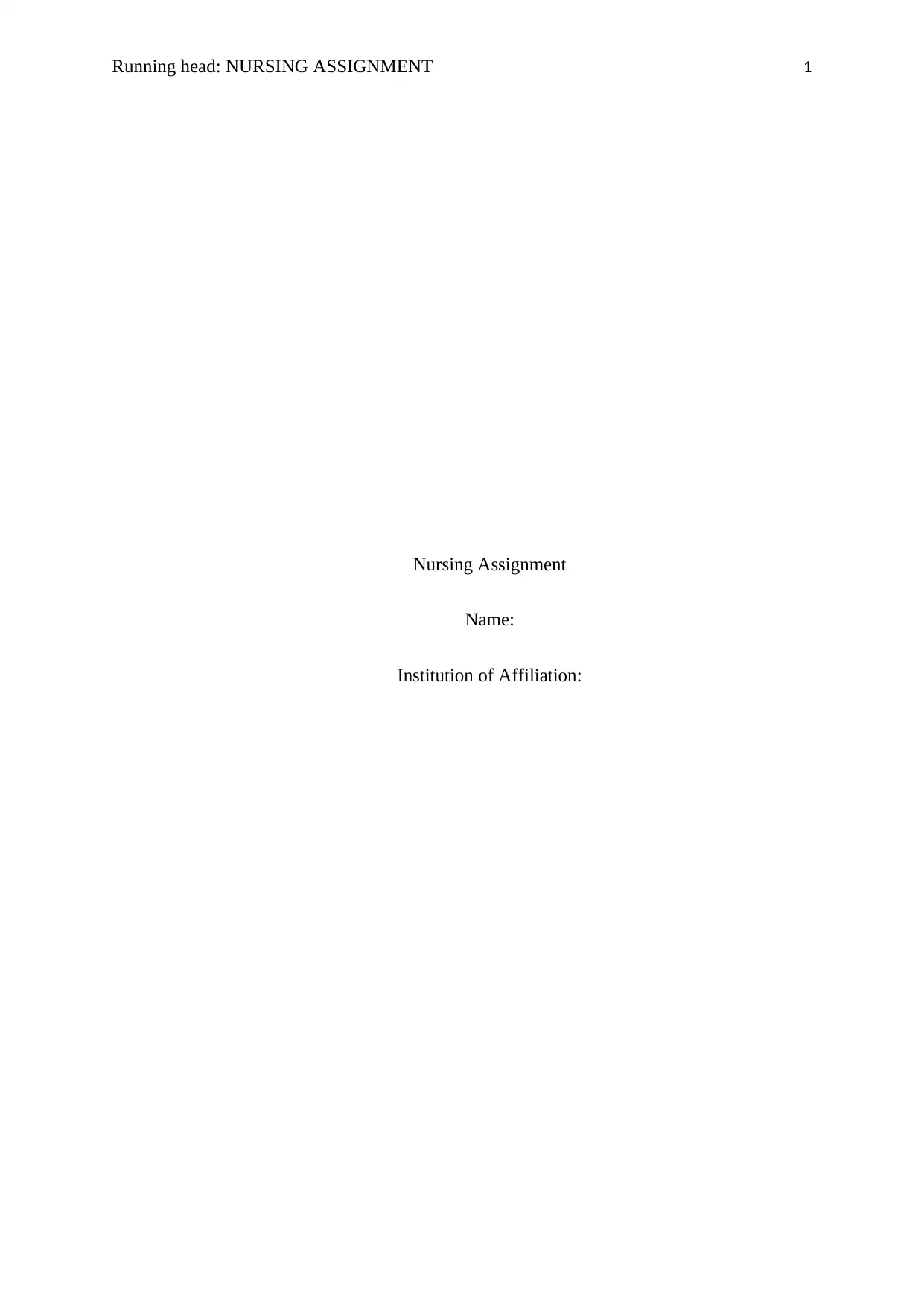
Running head: NURSING ASSIGNMENT 1
Nursing Assignment
Name:
Institution of Affiliation:
Nursing Assignment
Name:
Institution of Affiliation:
Paraphrase This Document
Need a fresh take? Get an instant paraphrase of this document with our AI Paraphraser
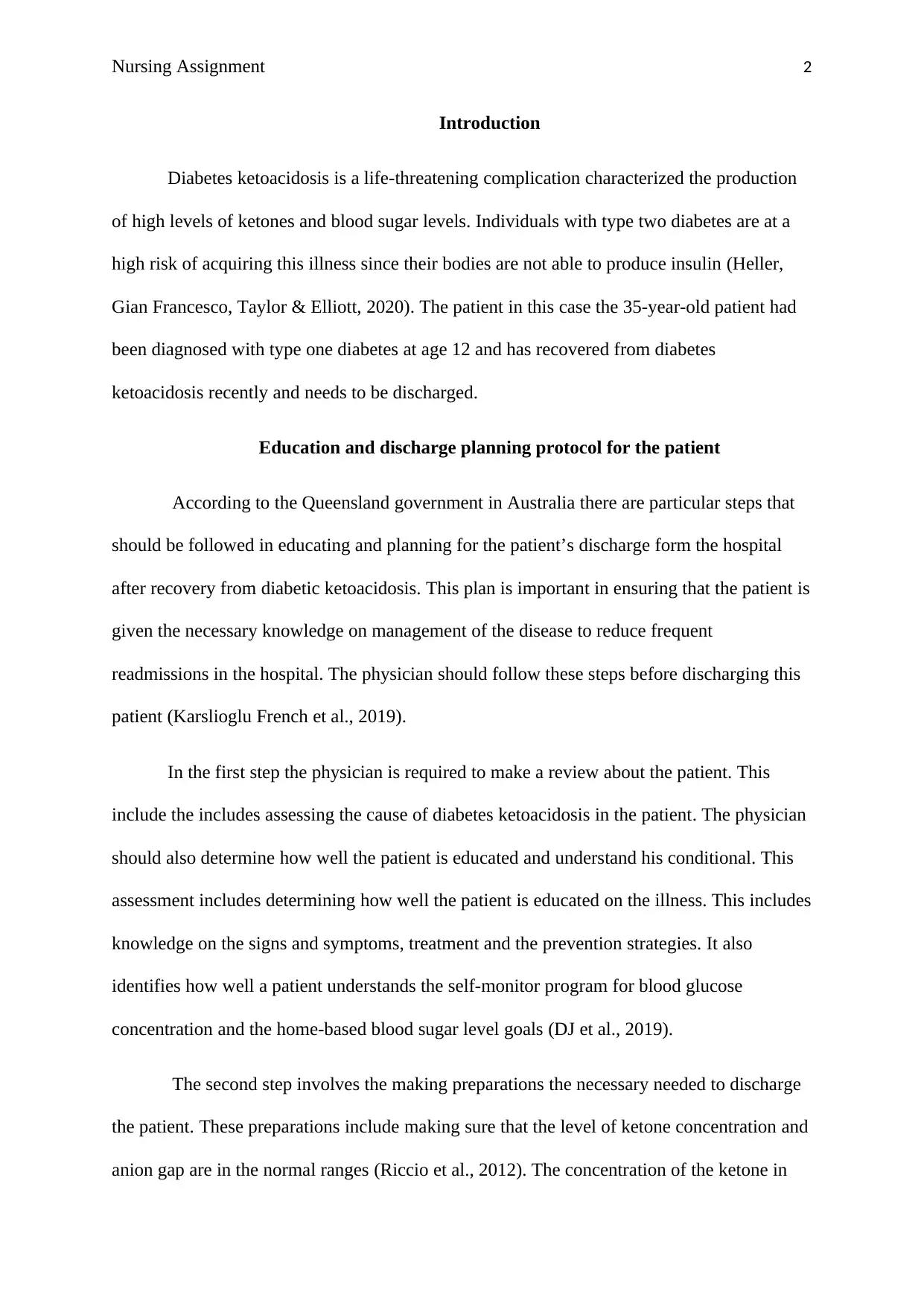
Nursing Assignment 2
Introduction
Diabetes ketoacidosis is a life-threatening complication characterized the production
of high levels of ketones and blood sugar levels. Individuals with type two diabetes are at a
high risk of acquiring this illness since their bodies are not able to produce insulin (Heller,
Gian Francesco, Taylor & Elliott, 2020). The patient in this case the 35-year-old patient had
been diagnosed with type one diabetes at age 12 and has recovered from diabetes
ketoacidosis recently and needs to be discharged.
Education and discharge planning protocol for the patient
According to the Queensland government in Australia there are particular steps that
should be followed in educating and planning for the patient’s discharge form the hospital
after recovery from diabetic ketoacidosis. This plan is important in ensuring that the patient is
given the necessary knowledge on management of the disease to reduce frequent
readmissions in the hospital. The physician should follow these steps before discharging this
patient (Karslioglu French et al., 2019).
In the first step the physician is required to make a review about the patient. This
include the includes assessing the cause of diabetes ketoacidosis in the patient. The physician
should also determine how well the patient is educated and understand his conditional. This
assessment includes determining how well the patient is educated on the illness. This includes
knowledge on the signs and symptoms, treatment and the prevention strategies. It also
identifies how well a patient understands the self-monitor program for blood glucose
concentration and the home-based blood sugar level goals (DJ et al., 2019).
The second step involves the making preparations the necessary needed to discharge
the patient. These preparations include making sure that the level of ketone concentration and
anion gap are in the normal ranges (Riccio et al., 2012). The concentration of the ketone in
Introduction
Diabetes ketoacidosis is a life-threatening complication characterized the production
of high levels of ketones and blood sugar levels. Individuals with type two diabetes are at a
high risk of acquiring this illness since their bodies are not able to produce insulin (Heller,
Gian Francesco, Taylor & Elliott, 2020). The patient in this case the 35-year-old patient had
been diagnosed with type one diabetes at age 12 and has recovered from diabetes
ketoacidosis recently and needs to be discharged.
Education and discharge planning protocol for the patient
According to the Queensland government in Australia there are particular steps that
should be followed in educating and planning for the patient’s discharge form the hospital
after recovery from diabetic ketoacidosis. This plan is important in ensuring that the patient is
given the necessary knowledge on management of the disease to reduce frequent
readmissions in the hospital. The physician should follow these steps before discharging this
patient (Karslioglu French et al., 2019).
In the first step the physician is required to make a review about the patient. This
include the includes assessing the cause of diabetes ketoacidosis in the patient. The physician
should also determine how well the patient is educated and understand his conditional. This
assessment includes determining how well the patient is educated on the illness. This includes
knowledge on the signs and symptoms, treatment and the prevention strategies. It also
identifies how well a patient understands the self-monitor program for blood glucose
concentration and the home-based blood sugar level goals (DJ et al., 2019).
The second step involves the making preparations the necessary needed to discharge
the patient. These preparations include making sure that the level of ketone concentration and
anion gap are in the normal ranges (Riccio et al., 2012). The concentration of the ketone in
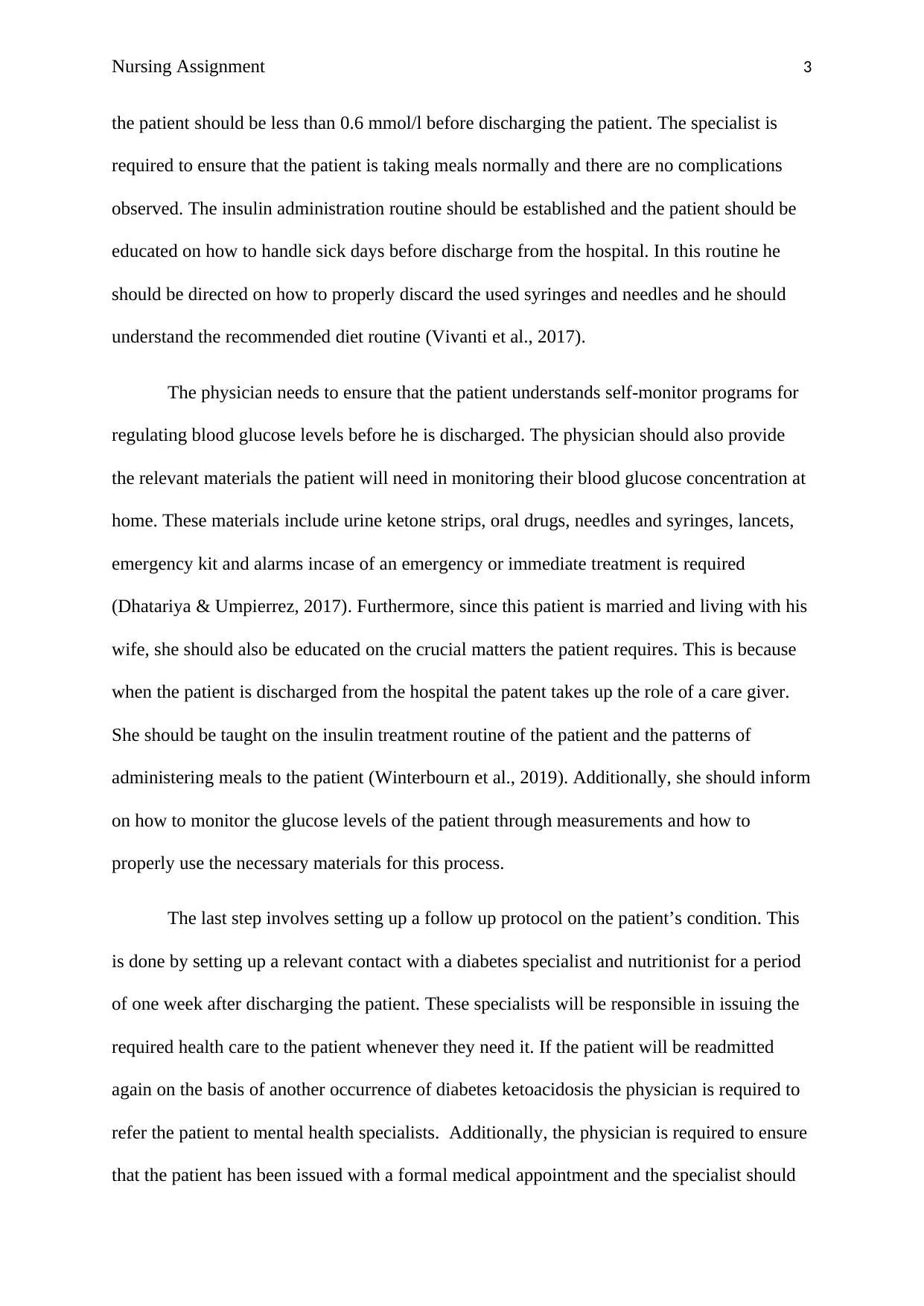
Nursing Assignment 3
the patient should be less than 0.6 mmol/l before discharging the patient. The specialist is
required to ensure that the patient is taking meals normally and there are no complications
observed. The insulin administration routine should be established and the patient should be
educated on how to handle sick days before discharge from the hospital. In this routine he
should be directed on how to properly discard the used syringes and needles and he should
understand the recommended diet routine (Vivanti et al., 2017).
The physician needs to ensure that the patient understands self-monitor programs for
regulating blood glucose levels before he is discharged. The physician should also provide
the relevant materials the patient will need in monitoring their blood glucose concentration at
home. These materials include urine ketone strips, oral drugs, needles and syringes, lancets,
emergency kit and alarms incase of an emergency or immediate treatment is required
(Dhatariya & Umpierrez, 2017). Furthermore, since this patient is married and living with his
wife, she should also be educated on the crucial matters the patient requires. This is because
when the patient is discharged from the hospital the patent takes up the role of a care giver.
She should be taught on the insulin treatment routine of the patient and the patterns of
administering meals to the patient (Winterbourn et al., 2019). Additionally, she should inform
on how to monitor the glucose levels of the patient through measurements and how to
properly use the necessary materials for this process.
The last step involves setting up a follow up protocol on the patient’s condition. This
is done by setting up a relevant contact with a diabetes specialist and nutritionist for a period
of one week after discharging the patient. These specialists will be responsible in issuing the
required health care to the patient whenever they need it. If the patient will be readmitted
again on the basis of another occurrence of diabetes ketoacidosis the physician is required to
refer the patient to mental health specialists. Additionally, the physician is required to ensure
that the patient has been issued with a formal medical appointment and the specialist should
the patient should be less than 0.6 mmol/l before discharging the patient. The specialist is
required to ensure that the patient is taking meals normally and there are no complications
observed. The insulin administration routine should be established and the patient should be
educated on how to handle sick days before discharge from the hospital. In this routine he
should be directed on how to properly discard the used syringes and needles and he should
understand the recommended diet routine (Vivanti et al., 2017).
The physician needs to ensure that the patient understands self-monitor programs for
regulating blood glucose levels before he is discharged. The physician should also provide
the relevant materials the patient will need in monitoring their blood glucose concentration at
home. These materials include urine ketone strips, oral drugs, needles and syringes, lancets,
emergency kit and alarms incase of an emergency or immediate treatment is required
(Dhatariya & Umpierrez, 2017). Furthermore, since this patient is married and living with his
wife, she should also be educated on the crucial matters the patient requires. This is because
when the patient is discharged from the hospital the patent takes up the role of a care giver.
She should be taught on the insulin treatment routine of the patient and the patterns of
administering meals to the patient (Winterbourn et al., 2019). Additionally, she should inform
on how to monitor the glucose levels of the patient through measurements and how to
properly use the necessary materials for this process.
The last step involves setting up a follow up protocol on the patient’s condition. This
is done by setting up a relevant contact with a diabetes specialist and nutritionist for a period
of one week after discharging the patient. These specialists will be responsible in issuing the
required health care to the patient whenever they need it. If the patient will be readmitted
again on the basis of another occurrence of diabetes ketoacidosis the physician is required to
refer the patient to mental health specialists. Additionally, the physician is required to ensure
that the patient has been issued with a formal medical appointment and the specialist should
⊘ This is a preview!⊘
Do you want full access?
Subscribe today to unlock all pages.

Trusted by 1+ million students worldwide
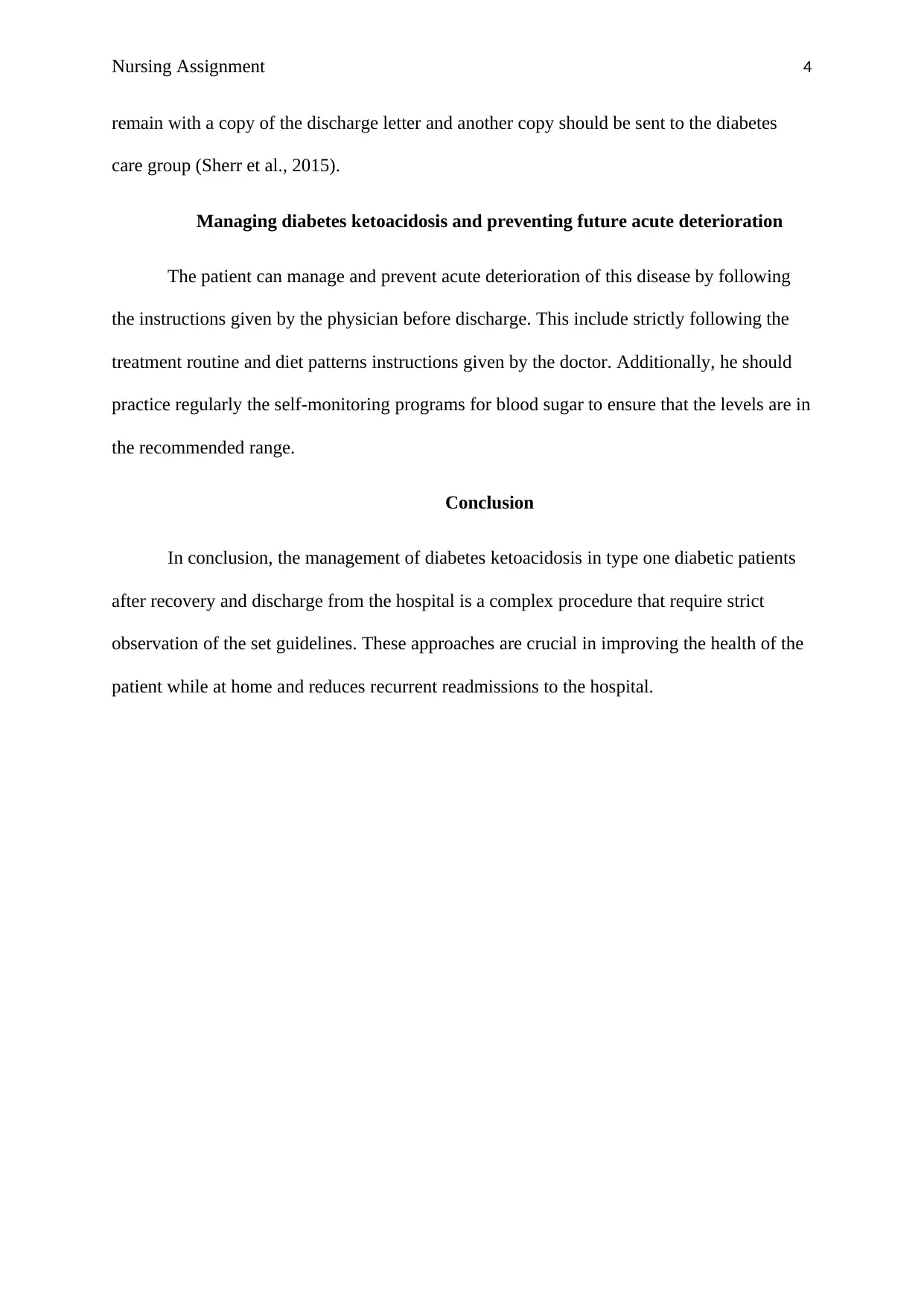
Nursing Assignment 4
remain with a copy of the discharge letter and another copy should be sent to the diabetes
care group (Sherr et al., 2015).
Managing diabetes ketoacidosis and preventing future acute deterioration
The patient can manage and prevent acute deterioration of this disease by following
the instructions given by the physician before discharge. This include strictly following the
treatment routine and diet patterns instructions given by the doctor. Additionally, he should
practice regularly the self-monitoring programs for blood sugar to ensure that the levels are in
the recommended range.
Conclusion
In conclusion, the management of diabetes ketoacidosis in type one diabetic patients
after recovery and discharge from the hospital is a complex procedure that require strict
observation of the set guidelines. These approaches are crucial in improving the health of the
patient while at home and reduces recurrent readmissions to the hospital.
remain with a copy of the discharge letter and another copy should be sent to the diabetes
care group (Sherr et al., 2015).
Managing diabetes ketoacidosis and preventing future acute deterioration
The patient can manage and prevent acute deterioration of this disease by following
the instructions given by the physician before discharge. This include strictly following the
treatment routine and diet patterns instructions given by the doctor. Additionally, he should
practice regularly the self-monitoring programs for blood sugar to ensure that the levels are in
the recommended range.
Conclusion
In conclusion, the management of diabetes ketoacidosis in type one diabetic patients
after recovery and discharge from the hospital is a complex procedure that require strict
observation of the set guidelines. These approaches are crucial in improving the health of the
patient while at home and reduces recurrent readmissions to the hospital.
Paraphrase This Document
Need a fresh take? Get an instant paraphrase of this document with our AI Paraphraser
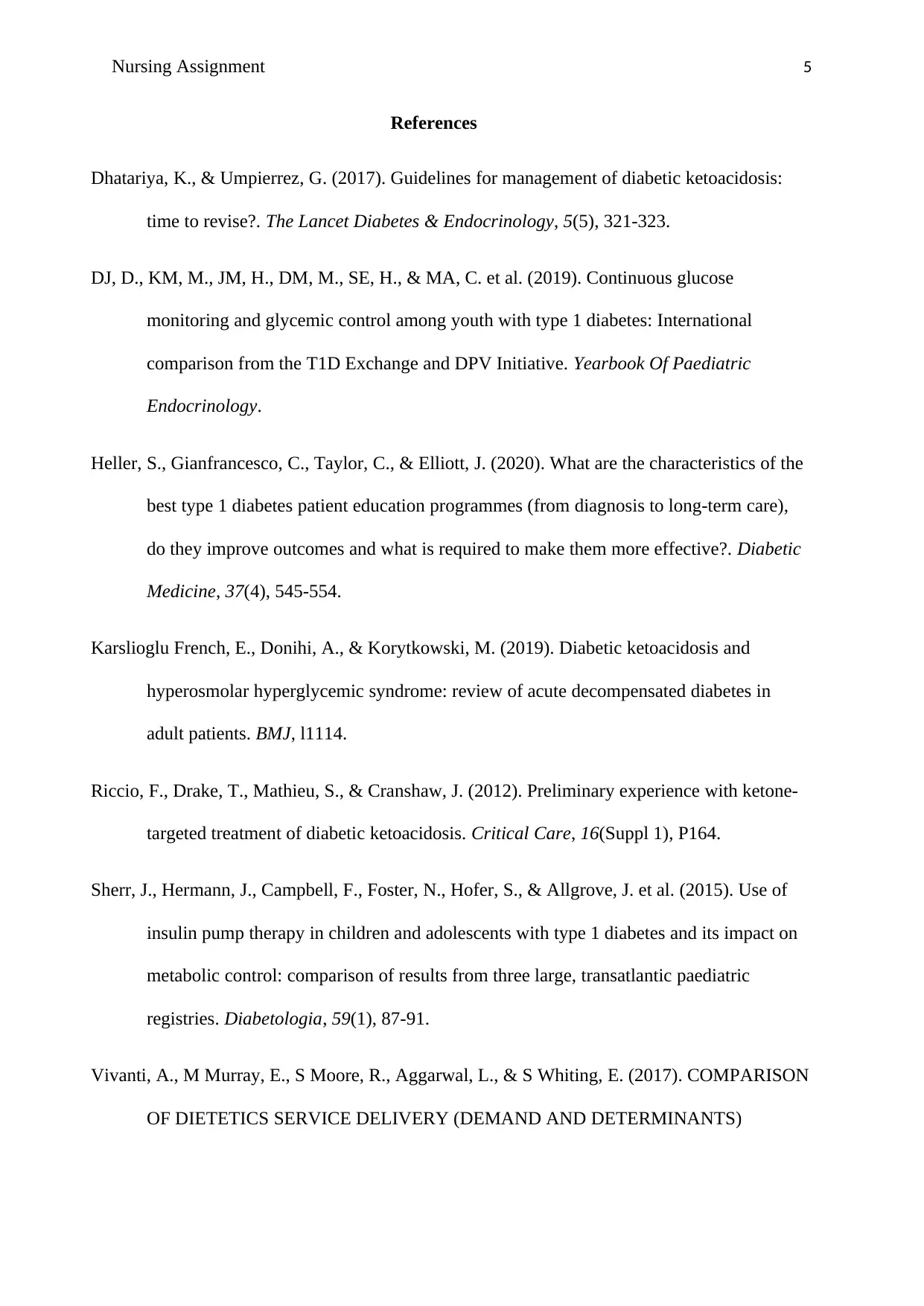
Nursing Assignment 5
References
Dhatariya, K., & Umpierrez, G. (2017). Guidelines for management of diabetic ketoacidosis:
time to revise?. The Lancet Diabetes & Endocrinology, 5(5), 321-323.
DJ, D., KM, M., JM, H., DM, M., SE, H., & MA, C. et al. (2019). Continuous glucose
monitoring and glycemic control among youth with type 1 diabetes: International
comparison from the T1D Exchange and DPV Initiative. Yearbook Of Paediatric
Endocrinology.
Heller, S., Gianfrancesco, C., Taylor, C., & Elliott, J. (2020). What are the characteristics of the
best type 1 diabetes patient education programmes (from diagnosis to long‐term care),
do they improve outcomes and what is required to make them more effective?. Diabetic
Medicine, 37(4), 545-554.
Karslioglu French, E., Donihi, A., & Korytkowski, M. (2019). Diabetic ketoacidosis and
hyperosmolar hyperglycemic syndrome: review of acute decompensated diabetes in
adult patients. BMJ, l1114.
Riccio, F., Drake, T., Mathieu, S., & Cranshaw, J. (2012). Preliminary experience with ketone-
targeted treatment of diabetic ketoacidosis. Critical Care, 16(Suppl 1), P164.
Sherr, J., Hermann, J., Campbell, F., Foster, N., Hofer, S., & Allgrove, J. et al. (2015). Use of
insulin pump therapy in children and adolescents with type 1 diabetes and its impact on
metabolic control: comparison of results from three large, transatlantic paediatric
registries. Diabetologia, 59(1), 87-91.
Vivanti, A., M Murray, E., S Moore, R., Aggarwal, L., & S Whiting, E. (2017). COMPARISON
OF DIETETICS SERVICE DELIVERY (DEMAND AND DETERMINANTS)
References
Dhatariya, K., & Umpierrez, G. (2017). Guidelines for management of diabetic ketoacidosis:
time to revise?. The Lancet Diabetes & Endocrinology, 5(5), 321-323.
DJ, D., KM, M., JM, H., DM, M., SE, H., & MA, C. et al. (2019). Continuous glucose
monitoring and glycemic control among youth with type 1 diabetes: International
comparison from the T1D Exchange and DPV Initiative. Yearbook Of Paediatric
Endocrinology.
Heller, S., Gianfrancesco, C., Taylor, C., & Elliott, J. (2020). What are the characteristics of the
best type 1 diabetes patient education programmes (from diagnosis to long‐term care),
do they improve outcomes and what is required to make them more effective?. Diabetic
Medicine, 37(4), 545-554.
Karslioglu French, E., Donihi, A., & Korytkowski, M. (2019). Diabetic ketoacidosis and
hyperosmolar hyperglycemic syndrome: review of acute decompensated diabetes in
adult patients. BMJ, l1114.
Riccio, F., Drake, T., Mathieu, S., & Cranshaw, J. (2012). Preliminary experience with ketone-
targeted treatment of diabetic ketoacidosis. Critical Care, 16(Suppl 1), P164.
Sherr, J., Hermann, J., Campbell, F., Foster, N., Hofer, S., & Allgrove, J. et al. (2015). Use of
insulin pump therapy in children and adolescents with type 1 diabetes and its impact on
metabolic control: comparison of results from three large, transatlantic paediatric
registries. Diabetologia, 59(1), 87-91.
Vivanti, A., M Murray, E., S Moore, R., Aggarwal, L., & S Whiting, E. (2017). COMPARISON
OF DIETETICS SERVICE DELIVERY (DEMAND AND DETERMINANTS)
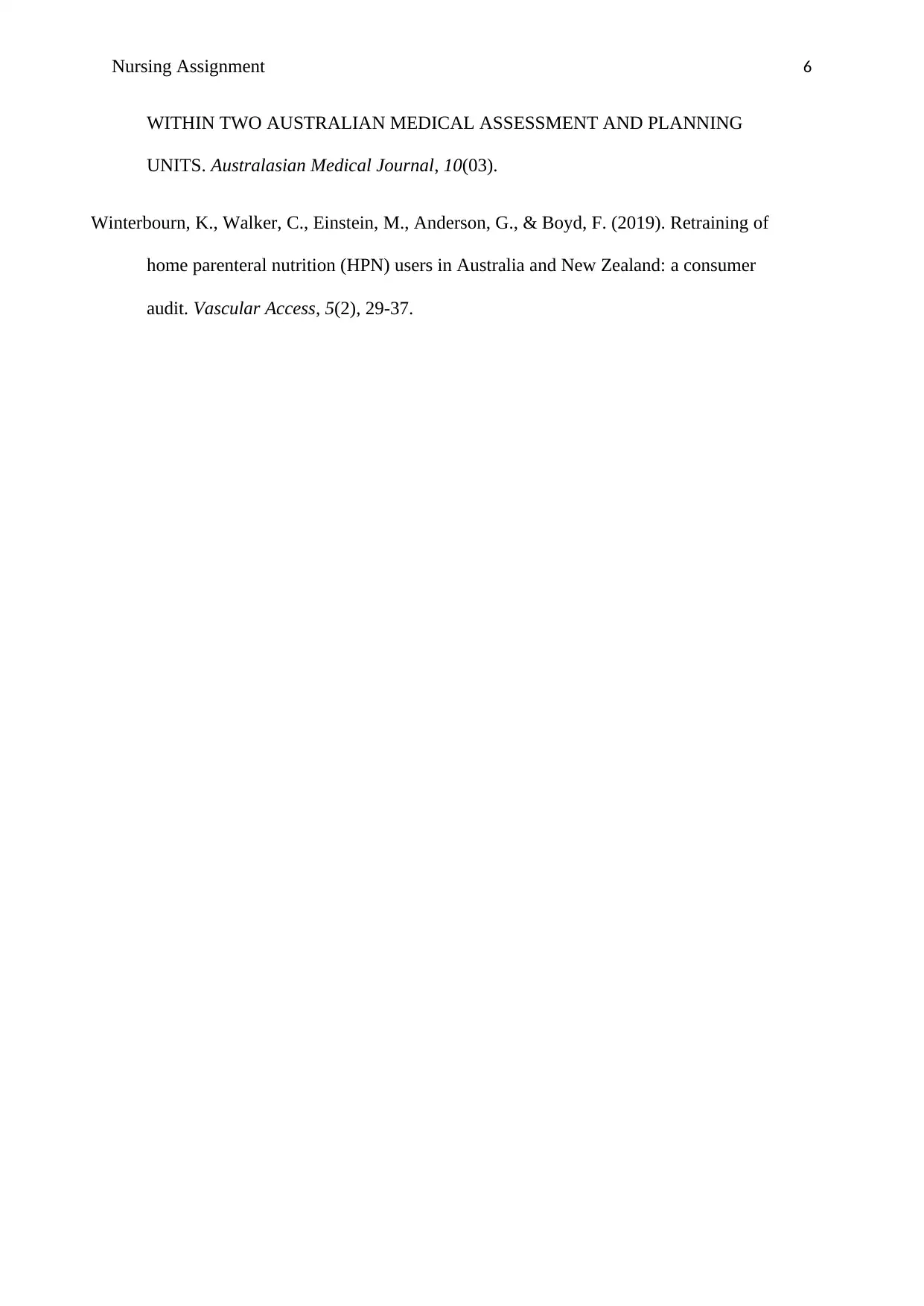
Nursing Assignment 6
WITHIN TWO AUSTRALIAN MEDICAL ASSESSMENT AND PLANNING
UNITS. Australasian Medical Journal, 10(03).
Winterbourn, K., Walker, C., Einstein, M., Anderson, G., & Boyd, F. (2019). Retraining of
home parenteral nutrition (HPN) users in Australia and New Zealand: a consumer
audit. Vascular Access, 5(2), 29-37.
WITHIN TWO AUSTRALIAN MEDICAL ASSESSMENT AND PLANNING
UNITS. Australasian Medical Journal, 10(03).
Winterbourn, K., Walker, C., Einstein, M., Anderson, G., & Boyd, F. (2019). Retraining of
home parenteral nutrition (HPN) users in Australia and New Zealand: a consumer
audit. Vascular Access, 5(2), 29-37.
⊘ This is a preview!⊘
Do you want full access?
Subscribe today to unlock all pages.

Trusted by 1+ million students worldwide
1 out of 6
Related Documents
Your All-in-One AI-Powered Toolkit for Academic Success.
+13062052269
info@desklib.com
Available 24*7 on WhatsApp / Email
![[object Object]](/_next/static/media/star-bottom.7253800d.svg)
Unlock your academic potential
Copyright © 2020–2025 A2Z Services. All Rights Reserved. Developed and managed by ZUCOL.





